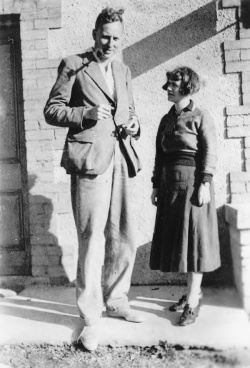Gregory Bateson
 Bateson with Margaret Mead in the late 1930s. Photo by C. H. Waddington. | |
| Born |
May 9, 1904 Grantchester, United Kingdom |
|---|---|
| Died |
April 14, 1980 (aged 78) San Francisco, United States |
Gregory Bateson was an English anthropologist, social scientist, linguist, visual anthropologist, semiotician and cyberneticist whose work intersected that of many other fields.
He was born in 1904 as the third and youngest son of [Caroline] Beatrice Durham and of the distinguished geneticist William Bateson. Resisting family pressures to follow in his father's footsteps, he completed his degree in anthropology instead of the natural sciences, and left England to do field work in New Guinea. It was on his second trip there, in 1956, that he met his fellow anthropologist Margaret Mead, whom he later married; their only child, Mary Catherine Bateson, is also an anthropologist. Bateson and Mead were divorced in 1950, but they continued to collaborate professionally and maintained their friendship until Mead's death in 1978.
In the years to follow, Bateson became a visiting professor of anthropology at Harvard (1947); was appointed research associate at the Langley Porrer Neuropsychiatric Institute in San Francisco; worked as ethnologist at the Palo Alto Veterans Administration Hospital (where he developed the double-bind theory of schizophrenia and formulated a new theory of learning). He worked with dolphins at the Oceanographic Institute in Hawaii and taught at the University of Hawaii. In 1972 he joined the University of California at Santa Cruz.
Visual anthropology
In the 1930s, Bateson and Mead conducted an ambitious photography and film project in Bali, inspired by Mead's conviction that visual anthropology could serve a scientific, objective anthropology. They studied the people of the Balinese village Bajoeng Gede. David Lipset states that "in the short history of [their] ethnographic fieldwork, film was used both on a large scale and as the primary research tool". Indeed, they took around 25,000 photographs, and also shot a short documentary Trance and Dance in Bali, which was not released until 1952. In 1999 the film was deemed "culturally significant" by the United States Library of Congress and selected for preservation in the National Film Registry.
Legacy
The documentary An Ecology of Mind (2011) by his daughter Nora Bateson premiered at the Vancouver International Film Festival.
Literature
- David Lipset, Gregory Bateson the Legacy of a Scientist, Beacon Press, 1982.
- Sarah Pink, "Interdisciplinary Agendas. (Re)situating Visual Anthropology", chapter 2 of The Future of Visual Anthropology: Engaging the Senses, London & New York: Routledge, 2006, pp 25-29.